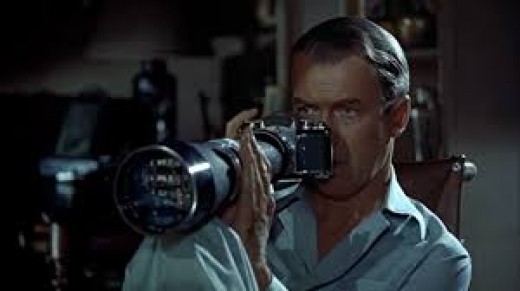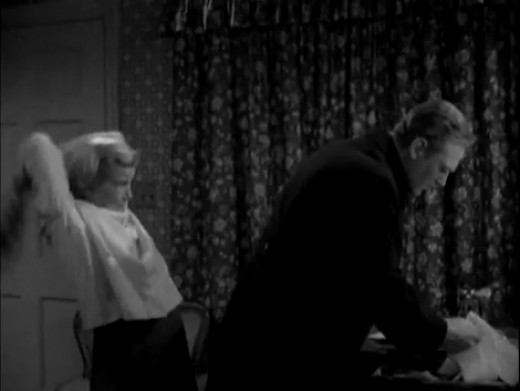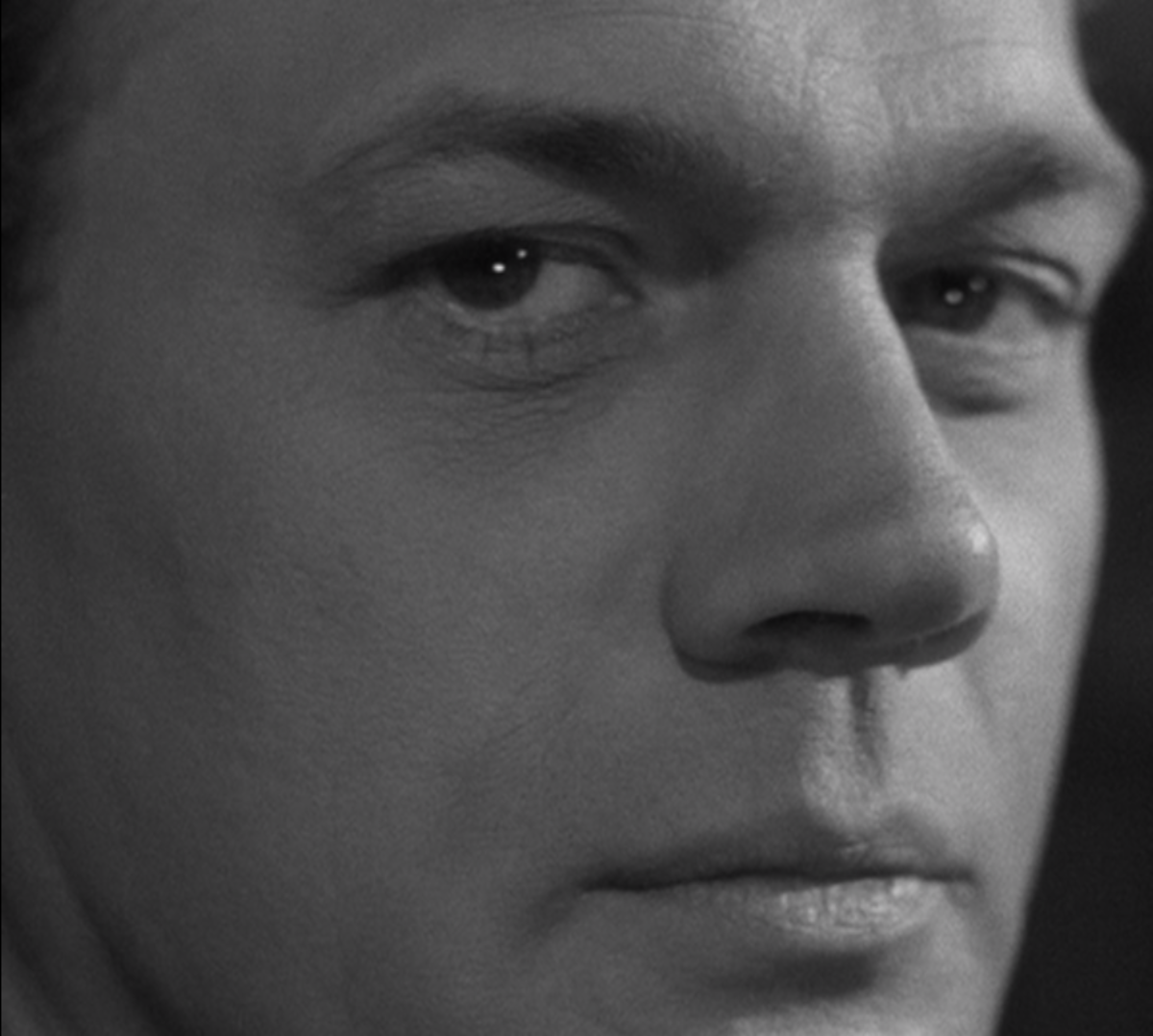Alfred Hitchcock's 'Rear Window' and Roald Dahl's 'Lamb to the Slaughter'

“It only takes one witness to spoil the perfect crime”. (1999 re-release) Hitchcock’s Rear Window expertly explores this idea through his manipulation of the traditional crime genre. While he adheres to many of the conventions, Hitchcock cleverly employs variations to these in order to construct a more realistic setting. Roald Dahl’s Lamb to the Slaughter challenges the conventions of traditional crime writing while exploring aspects of committing the ‘perfect crime’. Both Rear Window and Lamb to the Slaughter reflect prominent ideas and values of a 1950s American society.
Hitchcock’s setting of the apartment block conforms with the traditional closed circle, ensuring any crime would not go unnoticed. As the film opens the camera pans around the building complex, establishing the setting. These acts as a point of view shots as it also establishes what Jeffries can see of his neighbours. Hitchcock comments on society at this time where apartment living was common. In doing so, the morality of voyeurism is questioned. Although such actions of Jeffries ensures Thorwald’s crime is solved, Stella considers they’d “put out your eyes with a hot poker.” Initially, Jeffries’ voyeurism is perceived as “diseased” and reflects a “race of peeping toms”. However, both Lisa and Stella eventually become interested as the murder is uncovered. The setting in which Thorwald kills his wife would seem irrational to many. However, if Jeffries had not become suspicious the apartment block may have been the perfect setting to commit the crime as the formal detective discredits the idea. This is shown through Doyle’s conversation with Jeffries, saying “it’s too obvious a way to commit murder within view of fifty windows”. Hitchcock employs the use of high angles on Jeffries to enforce his lack of authority compared to Doyle. However, as Jeffries begins to present his evidence, although circumstantial, both Doyle and Jeffries are shot on an equal level, presenting Jeffries’ investigative potential equal to that of the professional. The apartment, while conforming to a realist setting ensures Thorwald’s crime does not go unnoticed. Therefore he could never commit the perfect crime.

Hitchcock’s detective characters form an interesting variation to the traditional crime writing conventions. While Jeffries is not a detective by profession, he plays the role. His personality is presented in the opening scene as the camera pans around his apartment, revealing a broken camera and action photographs. This establishes Jeffries as a brave and courageous man. Conventionally, he fits a realist detective’s characteristics. However, his impotence from being wheelchair bound restricts his physical ability. His conventional want of justice is conveyed through his relentless pursuit of Thorwald. This is achieved through the actor’s portrayal of the character who is always positioned at the window, intriguingly waiting for further developments. Confidence with Jeffries’ ability is instilled within the audience when he declares Thorwald is giving the “look of a man when he’s afraid someone might be looking.” This shows that Jeffries is competent in fulfilling the investigative role. Alternatively, the formal detective, Doyle, reflects police procedure of the time. Without evidence Doyle cannot search Thorwald’s apartment, commenting “a judge must ask for evidence” before issuing a search warrant. If a sole reliance was placed on formal investigation Thorwald may well have gotten away with murder. While Jeffries offers a variation to the traditional detective, his pursuit of justice ensures Thorwald could never commit the perfect crime.
The characters of Lisa and Stella challenge traditional conventions of crime writing, however, Hitchcock uses them to comment on the roles of women in 1950s society. Initially, these characters are presented as stereotypical women. Stella is a nurse who appreciates the ideals of marriage and dedication to her husband, while Lisa is presented as a glamorous femme fatale. As Jeffries convinces them of Thorwald’s guilt, Stella and Lisa become his physical investigators due to his physical impairment. This challenges traditional conventions where only males were detectives. Lisa’s courage is presented when she gets into Thorwald’s apartment. In finding Mrs Thorwald’s wedding ring Lisa plays an integral role in solving the crime. Thorwald’s inability to discard such evidence ensures he never commits the perfect crime.
Hitchcock’s depiction of Thorwald as the murderer fits within the traditional conventions of crime writing. From the outset of the film Thorwald is presented as the villain. This is established as the camera pans across Thorwald’s apartment, following his movement. He is seen fighting with his obviously ill wife. Furthermore, Thorwald’s villainous personality is presented in his backyard when he tells his neighbour to “shut up”. This personality fits the conventions for a traditional murderer. Furthermore, he is clever in attempting to cover up his wife’s murder. He evades Jeffries’ watch while disposing of his wife’s body, kills the snooping dog in the garden and disguises his mistress as his wife. In doing so, Hitchcock builds tension and suspense as the audience begins to question whether Thorwald is guilty after all. Jeffries also considers “for a minute [I thought] I was wrong”. Thorwald's calculation in covering up the murder and his belief that he could commit the perfect crime conventionally fits with the murderer's persona of traditional crime writing.
Dahl’s Lamb to the Slaughter offers distinct variations to the traditional crime writing conventions. In the context of a 1950s American society, Mary Maloney conforms to the ‘housewife’ stereotype, “waiting for her husband to come home from work.” However, with her becoming the murderer, the conventions of crime writing are challenged. Traditionally, only males were seen as murderers which is enforced as the police officers discuss it “impossible that she” would murder her husband. Although not explicitly said, Dahl implies through their dialogue that Mary’s husband is leaving her. This ensures the audience is sympathetic towards Mary and accept her motives to kill her husband. Dahl’s portrayal of the murder supports the lack of detail found in conventional crime writing. He writes she “simply walked up behind him and without any pause she swung the big frozen leg of lamb high in the air and brought it down as hard as she could on the back of his head.” Dahl does this to maintain the audience’s support of Mary. She does, however, conventionally fit with a murderer’s attempts to conceal their crime. She creates her alibi by travelling to the grocery store to pick up vegetables for dinner. In doing so Mary is accounted for at the time of her husband’s death, and in establishing this alibi Mary is assured she committed the perfect crime. Dahl challenges the conventions in many ways as the audience generally wants the criminal brought to justice. In Lamb to the Slaughter the responder is satisfied that Mary evades punishment for committing the perfect crime.

Mary, in Lamb to the Slaughter ensures she commits the perfect crime as she convinces the detectives to eat the murder weapon. Dahl uses black humour to depict the detectives as incompetent. He presents this through the use of dialogue between Mary and Noonan when she offers him a drink of whisky, saying “why don’t you have one yourself.” Mary cleverly distracts them from their investigation, highlighting their clumsiness and then urges them to eat the leg of lamb she used to murder her husband. Dahl employs dramatic irony here to heighten the black humour. The story ends as Noonan comments the murder weapon is “probably right under our very noses”, while eating the leg of lamb. This ensures there is no evidence and no way of solving the crime. Mary “begins to giggle” as she knows she will get away with the perfect crime. Dahl offers bold variations to traditional crime writing in satisfying the responder with no resolution to the murder.
In both Rear Window and Lamb to the Slaughter different aspects of crime writing are explored. While composers of both follow conventions specific to their context, they offer variations too. Hitchcock, in Rear Window explores the criminal’s belief in committing the perfect crime while Dahl constructs his story where a perfect crime is committed.





